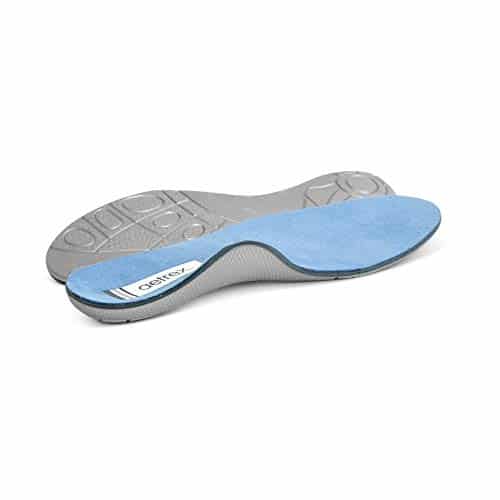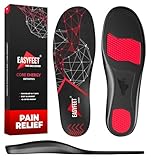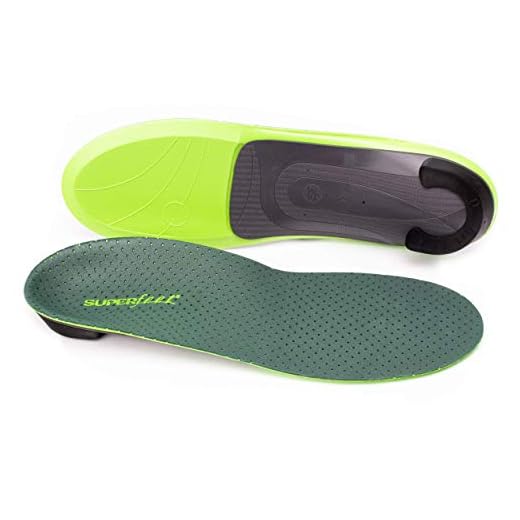
Insoles can be an excellent solution for those who suffer from foot pain. They are designed to provide additional support to the feet and improve foot function.
Insoles come in various shapes and sizes and can be made from different materials to cater to different foot types and conditions.
Foot pain can be caused by various factors, such as overuse, injury, or underlying medical conditions. It can affect different foot parts, such as the heel, arch, or ball.
Foot pain can be mild or severe, significantly impacting one’s quality of life. Insoles can help alleviate foot pain by providing cushioning, support, and proper alignment to the feet.
They can also help prevent further foot injuries and improve overall foot health.
Understanding Foot Pain
Foot pain is a common condition that affects people of all ages.
Various factors, including injury, overuse, and medical conditions such as neuropathy and arthritis, can cause it.
Understanding the symptoms of foot pain can help individuals identify the underlying cause of their discomfort and seek appropriate treatment.
Symptoms of Foot Pain
Foot pain can manifest in various ways, depending on the underlying cause. Some common symptoms include:
- Pain or tenderness in the foot or toes
- Swelling or inflammation
- Stiffness or limited range of motion
- Numbness or tingling
- Burning or shooting pain
- Difficulty walking or standing
Individuals experiencing foot pain should take note of the location, duration, and severity of their symptoms. This information can help medical professionals diagnose the underlying cause of the pain.
Diagnosis and Medical History
Medical professionals typically take a detailed medical history and conduct a physical examination to diagnose foot pain.
They may also order diagnostic tests such as X-rays or MRIs to identify any structural issues or abnormalities in the foot.
Individuals need to provide a complete medical history, including any previous injuries or medical conditions that may be contributing to their foot pain.
This information can help medical professionals identify the underlying cause of the pain and develop an appropriate treatment plan.
Neuropathy
Neuropathy is a common cause of foot pain, particularly in individuals with diabetes. This condition occurs when the nerves that control sensation in the feet become damaged, leading to numbness, tingling, and pain.
Treatment for neuropathy typically involves managing the underlying condition, such as diabetes, and taking medications to manage pain and improve nerve function.
Insoles can also be a helpful tool for individuals with neuropathy, as they can provide cushioning and support to the feet, reducing pressure on sensitive nerves.
Understanding the symptoms and causes of foot pain can help individuals seek appropriate treatment and manage their symptoms effectively. Consulting with a medical professional for an accurate diagnosis and treatment plan is essential.
Causes of Foot Pain
Various factors, including genetics, injury, and lifestyle choices, can cause foot pain. Sometimes, the pain may be due to an underlying medical condition. The following sub-sections will explore some of the most common causes of foot pain.
Flat Feet
Flat feet, also known as fallen arches, are a condition in which the arches of the feet collapse, causing the entire sole to touch the ground. This condition can be caused by genetics, injury, or footwear and tear over time.
Flat feet can cause pain in the feet, ankles, and knees and contribute to developing other foot conditions, such as plantar fasciitis and bunions.
High Arches
High arches, also known as cavus foot, is a condition in which the arches of the feet are raised higher than usual. This condition can be caused by genetics, injury, or neuromuscular disorders.
High arches can cause pain in the feet, ankles, and knees and contribute to developing other foot conditions, such as stress fractures and plantar fasciitis.
Plantar Fasciitis
Plantar fasciitis is when the plantar fascia, a band of tissue that runs along the bottom of the foot, becomes inflamed.
This condition is often caused by overuse, such as running or walking long distances or wearing shoes that do not provide adequate support. Plantar fasciitis can cause pain in the heel and arch of the foot, making it difficult to walk or stand for long periods.
Bunions
Bunions are bony bump that forms on the joint at the base of the big toe. This condition is often caused by genetics but can also be caused by wearing shoes that are too tight or narrow.
Bunions can cause pain and swelling in the affected area and make it challenging to wear shoes comfortably.
Stress Fractures
Stress fractures are small cracks in the bones of the feet caused by repetitive stress. This condition is often caused by overuse, such as running or jumping, or wearing shoes that do not provide adequate support.
Stress fractures can cause pain and swelling in the affected area, making walking or standing difficult for long periods.
Overall, foot pain can be caused by various factors, and it is essential to seek medical attention if the pain persists or is severe. By understanding the causes of foot pain, individuals can take steps to prevent and treat this common condition.
Aetrex Men's Premium Casual Orthotics W/Memory Foam for Superior Comfort & Cushioning. Insoles W/Arch Support That Help Relieve Foot Pain & Heel Pain
Powerstep Pinnacle Plus Metatarsal Pain Relief Orthotics - Shoe Inserts for Metatarsalgia, Arch Support, and General Ball of Foot Pain Relief - Shoe Insoles with Metatarsal Pad
$42.74 in stock
SelectFlex® 3 Way Adjustable Arch Support Orthotic Insole Inserts, Help Plantar Fasciitis, Neuropathy, Flat Feet, Overpronation, Foot Pain, Mortons Neuroma, & Lower Back Pain in Style. The Innovative Insoles that Work - Adjust your way to perfect support - Size - Women 13.5-15/Men 12.5-14.5
Preventing Foot Pain
One of the most effective ways to prevent foot pain is to take care of your feet and wear proper footwear. Here are some tips to help you prevent foot pain:
Choosing the Right Shoes
Choosing the right shoes is crucial for preventing foot pain. When shopping for shoes, looking for shoes that fit well and provide good support is essential. Here are some tips to help you choose the right shoes:
- Look for shoes that are comfortable and fit well. Make sure there is enough space for your toes to move around.
- Choose shoes that have a low heel and a wide toe box. High heels can put a lot of pressure on your feet and cause pain.
- Look for shoes that have good arch support. Shoes with a reinforced arch can help distribute weight evenly across your foot.
Insoles and Arch Support
Insoles and arch support can also help prevent foot pain. Here are some tips to help you choose the right insoles and arch support:
- Look for insoles that have a deep heel cup. This can help reduce pressure on your heel and provide better support.
- Consider using gel or foam insoles. These can help absorb shock and reduce pressure on your feet.
- Look for arch support that is designed for your foot type. If you have flat feet, look for arch support designed for flat feet.
Stretching and Exercise
Stretching and exercise can also help prevent foot pain. Here are some tips to help you stretch and exercise your feet:
- Stretch your feet regularly. This can help improve flexibility and reduce the risk of injury.
- Do exercises that strengthen your feet and ankles. This can help improve stability and reduce the risk of injury.
- Consider using orthotics. Orthotics can help provide additional support and cushioning for your feet.
These tips can help prevent foot pain and keep your feet healthy and pain-free.
Treating Foot Pain
When it comes to treating foot pain, a variety of options are available depending on the cause and severity of the pain.
Conservative measures are usually the first line of treatment, followed by medical treatment and, in some cases, surgery.
Conservative Measures
Conservative measures for treating foot pain can include lifestyle changes, home remedies, and over-the-counter pain relievers.
Lifestyle changes can include wearing comfortable shoes with good arch support, losing weight to reduce pressure on the feet, and avoiding high-impact activities exacerbating foot pain.
Home remedies such as ice, rest, and massage can also be effective in relieving foot pain. Additionally, doing exercises to strengthen the feet and stretching the calf muscles can help alleviate pain.
Over-the-counter pain relievers such as ibuprofen and naproxen sodium can also reduce pain and inflammation.
Medical Treatment
If conservative measures do not provide relief, medical treatment may be necessary. Medical treatment can include injections, prescription pain relievers, and physical therapy.
Injections of corticosteroids or platelet-rich plasma can effectively reduce inflammation and pain. Prescription pain relievers such as opioids may be prescribed in severe cases, but these medications come with a risk of addiction and should be used cautiously.
Physical therapy can also be effective in treating foot pain. A physical therapist can provide exercises and stretches to strengthen the feet and improve flexibility.
Surgery
In some cases, surgery may be necessary to treat foot pain. Surgery is typically reserved for cases where conservative measures and medical treatment have failed to provide relief.
Surgical options for foot pain include removing damaged tissue, correcting deformities, and fusing bones to stabilize the foot. Surgery is generally considered a last resort and should only be considered after all other treatment options have been exhausted.
Overall, there are a variety of options available for treating foot pain. Conservative measures such as lifestyle changes and home remedies are usually the first line of treatment, followed by medical treatment and surgery if necessary. It is essential to seek medical advice if foot pain persists or worsens, as early intervention can help prevent further damage.
Aetrex Men's Premium Casual Orthotics W/Memory Foam for Superior Comfort & Cushioning. Insoles W/Arch Support That Help Relieve Foot Pain & Heel Pain
Powerstep Pinnacle Plus Metatarsal Pain Relief Orthotics - Shoe Inserts for Metatarsalgia, Arch Support, and General Ball of Foot Pain Relief - Shoe Insoles with Metatarsal Pad
$42.74 in stock
SelectFlex® 3 Way Adjustable Arch Support Orthotic Insole Inserts, Help Plantar Fasciitis, Neuropathy, Flat Feet, Overpronation, Foot Pain, Mortons Neuroma, & Lower Back Pain in Style. The Innovative Insoles that Work - Adjust your way to perfect support - Size - Women 13.5-15/Men 12.5-14.5
Insoles for Foot Pain
Various factors, including flat feet, plantar fasciitis, metatarsalgia, and more, can cause foot pain. Insoles can relieve by cushioning the feet, reducing shock, and providing proper alignment.
In this section, we will discuss the different types of insoles, how to choose the right ones and the best insoles for different types of foot pain.
Types of Insoles
There are several types of insoles available on the market, including:
- Cushioning insoles: These insoles are made of memory foam or gel and provide extra cushioning for the feet.
- Orthotic insoles: These insoles are designed to provide proper foot alignment and support. Podiatrists often recommend them for people with foot pain or other foot problems.
- Over-the-counter insoles are available without a prescription and can be found at most drugstores. They are a more affordable option than custom-made orthotics.
Choosing the Right Insoles
When choosing insoles for foot pain, it is essential to consider the following factors:
- Type of foot pain: Different types of foot pain require different insoles. For example, if you have plantar fasciitis, you may need insoles with a deep heel cradle to provide extra support for your heel.
- Arch type: Insoles are available for different arch types, including high arches, flat feet, and neutral arches. It is essential to choose insoles that are designed for your specific arch type.
- Shoe type: Insoles come in different shapes and sizes, so choosing insoles that fit correctly in your shoes is essential. Some insoles are designed for specific shoes, such as athletic or dress shoes.
- Material: Insoles are made of different materials, including foam, gel, and cork. Choosing insoles made of materials that are comfortable for your feet and provide the right amount of support is essential.
Best Insoles for Different Types of Foot Pain
Here are some of the best insoles for different types of foot pain:
- Plantar fasciitis: Superfeet Green insoles are designed to provide extra support for the heel and arch, which can help relieve pain caused by plantar fasciitis.
- Metatarsalgia: Dr. Scholl’s Massaging Gel insoles provide extra cushioning for the ball of the foot, which can help relieve pain caused by metatarsalgia.
- Flat feet: Spenco Total Support Max insoles are designed to provide extra support for flat feet, which can help relieve pain and prevent further foot problems.
- Athletic activities: Non-slip insoles like the Powerstep Pinnacle Maxx insoles are designed to provide extra support and prevent slipping during athletic activities.
In conclusion, insoles can relieve foot pain by cushioning the feet, reducing shock, and providing proper alignment. Choosing the right insoles can relieve foot pain and prevent further problems. When choosing insoles, it is essential to consider the type of foot pain, arch type, shoe type, and material by choosing the right insoles.
Conclusion
Insoles effectively reduce foot pain and improve daily activities for individuals with foot pain.
A study published in PubMed found that insoles significantly reduce pain and pain interference with daily activities for women with foot pain.
However, satisfaction with the insoles does not necessarily predict actual insole use. Further studies are needed to determine the effect of insoles on activity performance.
A study published in PubMed found that metatarsal pads improve the American Orthopaedic Foot & Ankle Society score and reduce pain.
Metatarsal pads have also been found to reduce pain and improve foot function in individuals with metatarsalgia. This condition primarily affects women and is often preceded by extensive use of high heels and standing work.
When looking for insoles, it is essential to consider the level of support and stability they provide. Podiatrist-recommended insoles, such as those listed by Good Housekeeping, are often firm and provide excellent stability and arch support. Deep heel cups can also help align the feet properly to prevent end-of-day foot pain.
Orthotics or insoles are commonly recommended to help treat foot conditions like plantar fasciitis. They can be used by athletes and non-athletes alike to support, protect, or enhance natural foot function.
However, it is essential to consult a healthcare professional to determine the best type of insole or orthotic for individual needs.
In conclusion, insoles effectively reduce foot pain and improve daily activities for individuals with foot pain.
Metatarsal pads and podiatrist-recommended insoles are available to individuals seeking relief from foot pain. However, it is essential to consult a healthcare professional to determine the best option for individual needs.
Aetrex Men's Premium Casual Orthotics W/Memory Foam for Superior Comfort & Cushioning. Insoles W/Arch Support That Help Relieve Foot Pain & Heel Pain
Powerstep Pinnacle Plus Metatarsal Pain Relief Orthotics - Shoe Inserts for Metatarsalgia, Arch Support, and General Ball of Foot Pain Relief - Shoe Insoles with Metatarsal Pad
$42.74 in stock




































































